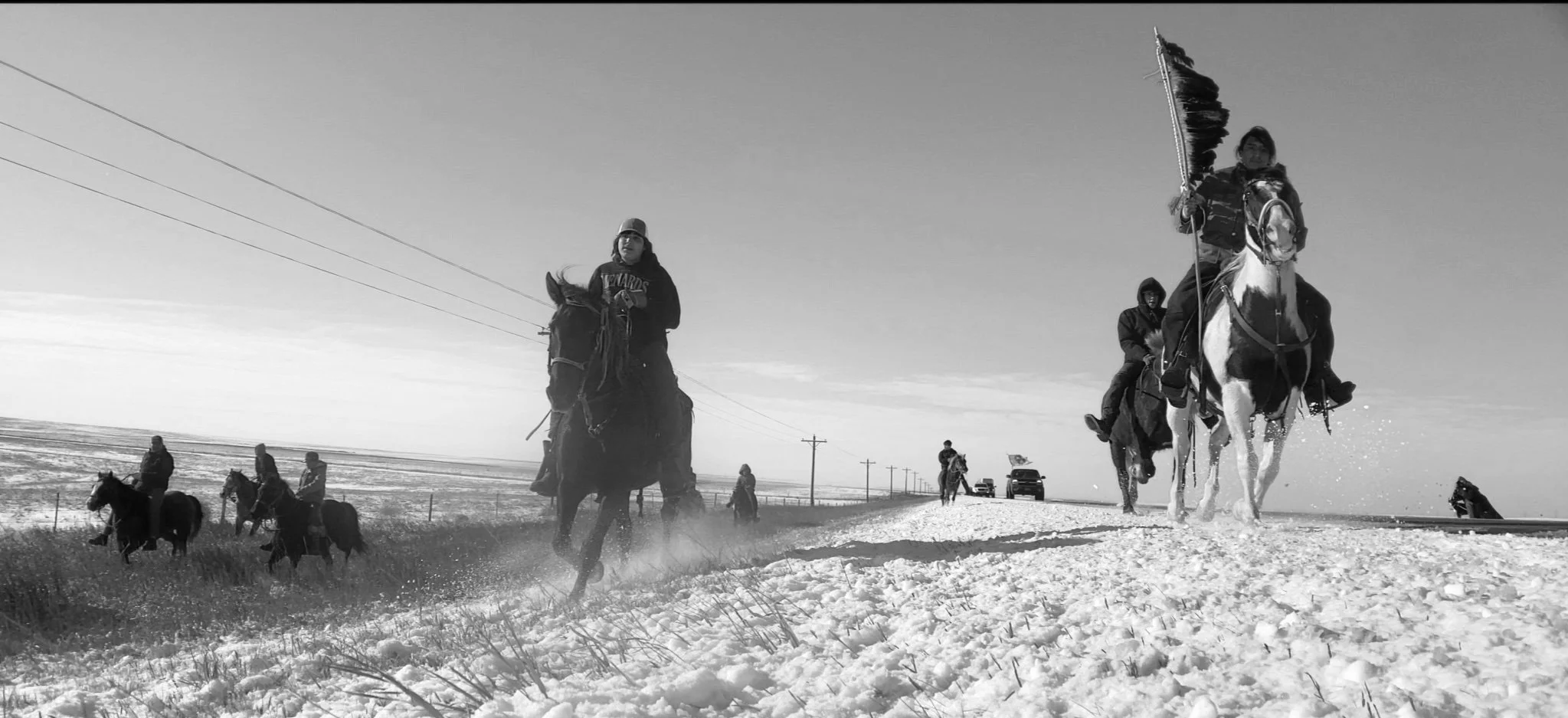LaDuke: What’s tragic about this story is everything: Christmas in Mankato, Dakota 38+2
By Winona LaDuke January 12, 2022
“I am not interested in picking up crumbs of compassion thrown from the table of someone who considers himself my master. I want the full menu of rights.”
The long ride is easier on horse than on foot. The annual Dakota 38 Plus Two Horse Ride commemorates the Christmas Day hanging of 38 Dakota men at Mankato, Minnesota, in 1862.
Four-thousand Minnesotans came out to watch the hanging, many throwing cold water on the Dakota. Hooded, when the men dropped, it is said they held hands and were singing a Dakota prayer song. Three years later, Shakopee and Medicine Bottle, who had fled to Canada, were drugged and brought back to die on the gallows on Nov. 11 at Fort Snelling.
This year, I rode part of that Dakota 38 Ride, from the Fort Thompson Reservation in South Dakota, home of the exiled Dakotas, along long stretches of South Dakota highways to Flandreau reservation, then through the Minnesota River Valley. That river valley has to be one of the most beautiful places in this territory.
I rode with grandsons and brought a good number of horses for the 230-mile ride. Grueling in the least, and full of prayers, grief, and awe, the lessons learned are unforgettable and deep. I rode with probably 25 young men under 25 and fewer elders.
What’s tragic about this story is everything. Crow Creek and Fort Thompson reservations, set up as prison camps for the exiled Dakotas, still have such great poverty, while Minnesota has never fully acknowledged this crime against humanity and the wealth and lives stolen from the Dakota people.
“We’re riding for all of the exiles and the exiles across this land because almost all Natives can’t live in their own lands anymore. They’re put in a little reservation somewhere, or some of them were relocated to the cities,” Jim Hallum a ride organizer, explained to a reporter.
Those that lost their lives on the gallows were disposed of in a shallow sand grave on a nearby riverbank, some to be dug up shortly thereafter to be dissected as medical cadavers. That’s some dark history Minnesota. And later, when the Walker Art Museum put up a replica of the gallows in 2017, that didn’t make anyone feel like healing had begun.
What do justice, reconciliation look like?
Minnesota Sen. Mary Kunesh, DFL-District 4, and outgoing Commissioner of Transportation Margaret Kelliher welcomed the riders. They joined 1,000 people who came to honor the horses and riders, and later, runners who came from Fort Thompson. That was a long run, and a long ride, and the food and reception were gracious.
What does justice look like for the Dakota 38 Plus Two? Think of it this way: Dakota land built Minnesota. The 1851 Treaty Territory of the Dakota is 20 miles wide along the Minnesota River Valley. Then came encroachments like New Ulm and lots of greed from land speculators. The Treaty of l851 transferred land to the U.S., and with the passage of the July 1862 Morrill Act, financed a whole list of universities, from the University of Minnesota to Cornell University
Under the act, over 1.2 million acres of land were taken from the Wahpekuta-Medewakanton, Wahpeton and Sisseton bands, representing the largest land theft by universities in the country. Some 35 universities secured land under the Act, which was passed just before the “Dakota uprising” in July of 1862. 1.2 million acres for $33,000.
Nice land speculating: All you have to do is exile the people who belong to the land and conduct the largest mass hanging in history.
What does reconciliation look like? The University of Minnesota recently announced a tuition waiver for Native students, largely because the university was built on these ill-begotten gains. The tuition waiver begins at all campuses in 2022.
“For 170 years, our University has focused attentively on the needs of all Minnesotans. Today we are taking a positive step forward in addressing the needs of indigenous peoples with a history that predates this state and institution,” said university president Joan Gabel. Honestly, it seems like a tuition waiver 160 years later is a bit cheap.
Oren Lyons, a great Onondaga chief always reminds us that “the only compensation for land is land.” Minnesota has a clear moral mandate to return land through land back movements and state and federal transfers to Native peoples. South and North Dakota do as well
With the recent passing of the Archbishop Desmond Tutu, I am reminded of his words: “I am not interested in picking up crumbs of compassion thrown from the table of someone who considers himself my master. I want the full menu of rights.” This next year marks the 120th anniversary of the hanging. That seems like an auspicious time to make a real reconciliation. Many of the young men who rode 230 miles to Mankato this Christmas were about the age of the men who were hung so long ago.
The next generation is coming, just as a new spring will come to the Minnesota River, and with it new grass. Let us strive to be full of hope, love and reconciliation as the seasons surely change.
Indakiingimin, “the land to which the people belong,” the land remembered in our songs and our spirits will sound and rise again when 4,000 people come this time to welcome home the Dakota and to return their land. I believe that will be the beginning of real reconciliation.



